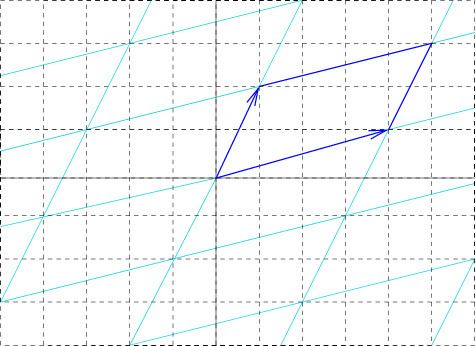 | ||
In mathematics, each closed surface in the sense of geometric topology can be constructed from an even-sided oriented polygon, called a fundamental polygon, by pairwise identification of its edges.
Contents
- Examples
- Group generators
- Standard fundamental polygons
- Fundamental polygon of a compact Riemann surface
- Metric fundamental polygon
- Fricke canonical polygon
- Area
- Explicit form for standard polygons
- Generalizations
- References
This construction can be represented as a string of length 2g of g distinct symbols where each symbol appears twice with exponent either +1 or −1. The exponent −1 signifies that the corresponding edge has the orientation opposing the one of the fundamental polygon.
Examples
Group generators
For the set of standard, symmetric shapes, the symbols of the edges of the polygon may be understood to be the generators of a group. Then, the polygon, written in terms of group elements, becomes a constraint on the free group generated by the edges, giving a group presentation with one constraint.
Thus, for example, given the Euclidean plane
For the torus, the constraint on the free group in two letters is given by
In practice, most of the interesting cases are surfaces with negative curvature, and are thus realized by a discrete lattice
Standard fundamental polygons
An orientable closed surface of genus n has the following standard fundamental polygon:
This fundamental polygon can be viewed as the result of gluing n tori together, and hence the surface is sometimes called the n-fold torus. ("Gluing" two surfaces means cutting a disk out of each and identifying the circular boundaries of the resulting holes.)
A non-orientable closed surface of (non-orientable) genus n has the following standard fundamental polygon:
Alternately, the non-orientable surfaces can be given in one of two forms, as n Klein bottles glued together (this may be called the n-fold Klein bottle, with non-orientable genus 2n), or as n glued real projective planes (the n-fold crosscap, with non-orientable genus n). The n-fold Klein bottle is given by the 4n-sided polygon
(note the final
That these two cases exhaust all the possibilities for a compact non-orientable surface was shown by Henri Poincaré.
Fundamental polygon of a compact Riemann surface
The fundamental polygon of a (hyperbolic) compact Riemann surface has a number of important properties that relate the surface to its Fuchsian model. That is, a hyperbolic compact Riemann surface has the upper half-plane as the universal cover, and can be represented as a quotient manifold H/Γ where Γ is a non-Abelian group isomorphic to the deck transformation group of the surface. The cosets of the quotient space have the standard fundamental polygon as a representative element. In the following, note that all Riemann surfaces are orientable.
Metric fundamental polygon
Given a point
Here, d is a hyperbolic metric on the upper half-plane. The metric fundamental polygon is more usually called the Dirichlet polygon .
Fricke canonical polygon
Given a Riemann surface of genus g greater than one, Fricke described another fundamental polygon, the Fricke canonical polygon, which is a very special example of a Dirichlet polygon. The polygon is related to the standard presentation of the fundamental group of the surface. Fricke's original construction is complicated and described in Fricke & Klein (1897). Using the theory of quasiconformal mappings of Ahlfors and Bers, Keen (1965) gave a new, shorter and more precise version of Fricke's construction. The Fricke canonical polygon has the following properties:
The above construction is sufficient to guarantee that each side of the polygon is a closed (non-trivial) loop in the Riemann surface H/Γ. As such, each side can thus an element of the fundamental group
The genus of the Riemann surface H/Γ is g.
Area
The area of the standard fundamental polygon is
Explicit form for standard polygons
Explicit expressions can be given for the regular standard 4g-sided polygon, with rotational symmetry. In this case, that of a genus
for
and
and
It may be verified that these generators obey the constraint
which gives the totality of the group presentation.
Generalizations
In higher dimensions, the idea of the fundamental polygon is captured in the articulation of homogeneous spaces.
